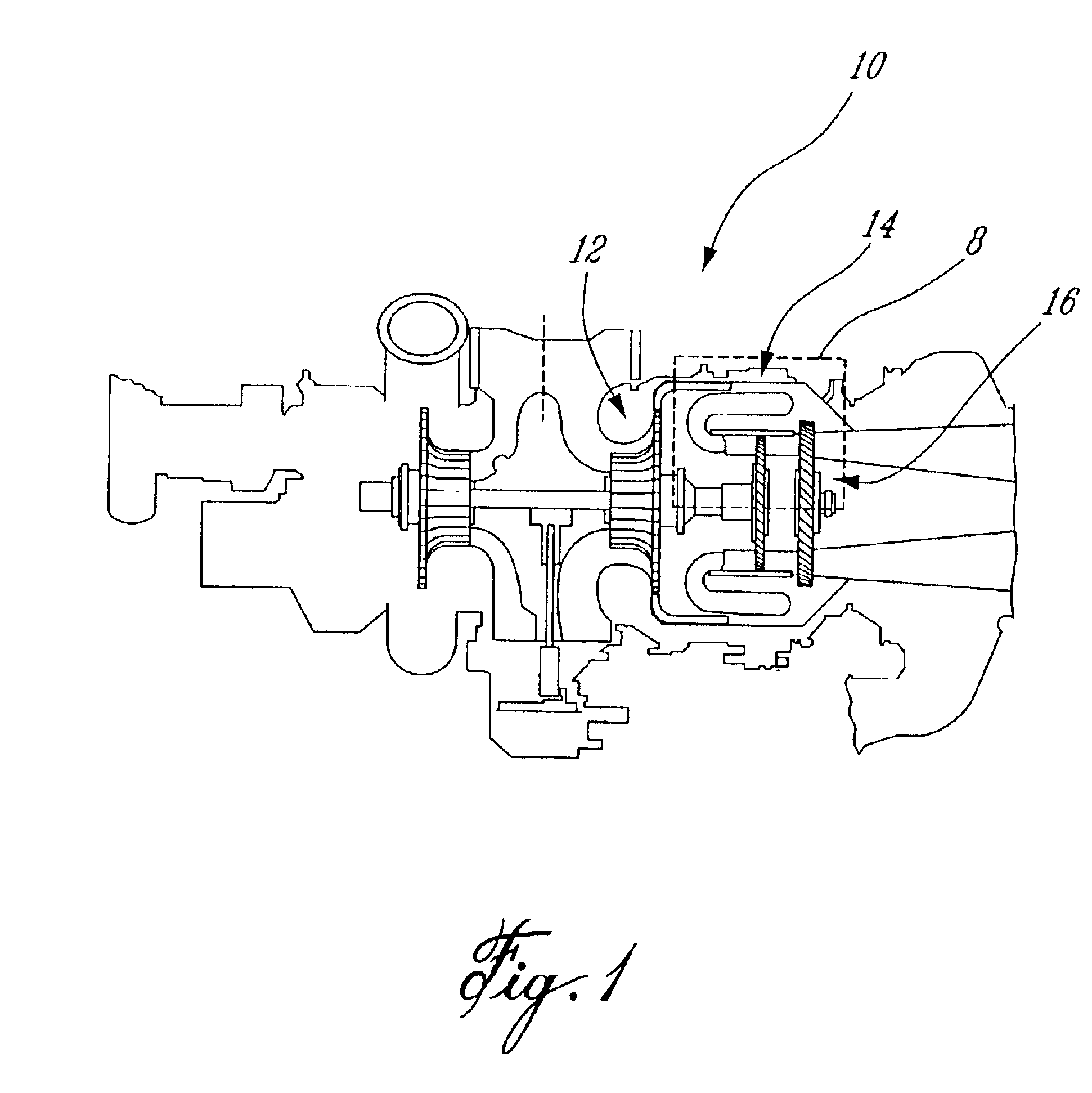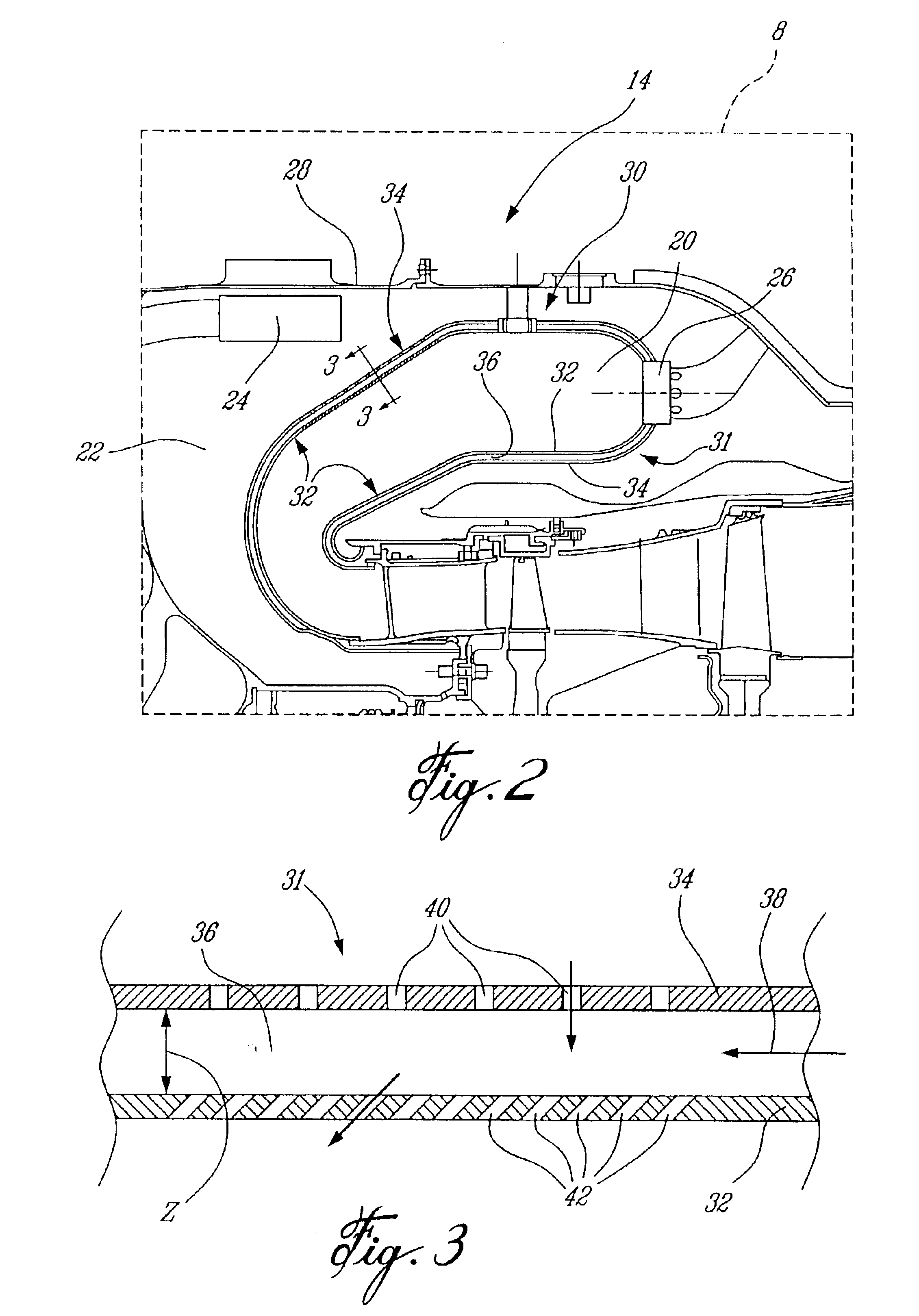Noise reducing combustor
a combustion chamber and noise reduction technology, applied in the direction of machines/engines, mechanical equipment, lighting and heating apparatus, etc., can solve the problems of not teaching or suggesting the use of a similar or modified combustion chamber wall construction, and the noise produced by gas turbine engines is largely caused
- Summary
- Abstract
- Description
- Claims
- Application Information
AI Technical Summary
Benefits of technology
Problems solved by technology
Method used
Image
Examples
first embodiment
[0027]Referring to FIGS. 4a and 4b, the relative arrangement of impingement apertures 40 and effusion apertures 42 is clearly seen. Particularly, a group of 3 effusion apertures 42 is disposed relative to each impingement aperture 40. The effusion apertures 42 in each group are preferably equally spaced from one another, being arranged at vertices of an equilateral triangle defined by the effusion apertures 42. The impingement aperture 40 is preferably disposed with each such triangular group of effusion apertures 42, being positioned closest to the effusion aperture 42 that is located most upstream relative to the direction of flow 38 through the cavity 36 of the combustor double-wall 31. The effusion apertures 42 of each group are spaced apart in a stream-wise direction, substantially parallel to the direction of flow 38, by a distance x, and in the span-wise direction, substantially perpendicular to the direction of flow 38, by a distance y. The impingement apertures 40 are space...
second embodiment
[0029]Referring now to the alternate arrangement of impingement apertures 40 and effusion apertures 42 in the second embodiment FIG. 5, in which the ratio of the number of effusion apertures 42 to the number of impingement apertures 40 is 2:1. Particularly, a group of 3 effusion apertures 42 is disposed relative to each impingement aperture 40, but each group of effusion apertures 42 shares two effusion apertures 42 with opposed adjacent groups. Therefore, each impingement aperture 40 is disposed downstream, relative to a direction of fluid flow 38 in the cavity 36, of an effusion aperture 42, and two effusion apertures 42, each shared with an adjacent group on either side of the impingement aperture 40, are disposed downstream again therefrom. As such, for each impingement aperture 40 in this embodiment there is one whole and two “half”, or shared, effusion apertures 42, and thereby a ratio of the number of effusion apertures 42 to the number of impingement apertures 40 of 2:1.
third embodiment
[0030]Referring to the alternate arrangement of impingement apertures 40 and effusion apertures 42 in the third embodiment FIG. 6, in which the ratio of the number of effusion apertures 42 to the number of impingement apertures 40 is 4:1. In this embodiment, each impingement aperture 10 is positioned substantially at a center of a group of four effusion apertures 42, disposed at vertices of a square oriented such that the centers of two effusion apertures 42 are coincident with a stream-wise axis 46 passing through the center of the impingement aperture 40, and two effusion apertures 42 are coincident with a span-wise axis 48 passing through the center of the impingement aperture 40. The span-wise and stream-wise directions are relative to a direction of fluid flow 38 through the cavity 36 between the inner effusion wall 32 and the outer impingement wall 34 of the combustor double-wall 31. Such groups of four effusion apertures 42 are repeated an equal span-wise distance from one an...
PUM
 Login to View More
Login to View More Abstract
Description
Claims
Application Information
 Login to View More
Login to View More - R&D
- Intellectual Property
- Life Sciences
- Materials
- Tech Scout
- Unparalleled Data Quality
- Higher Quality Content
- 60% Fewer Hallucinations
Browse by: Latest US Patents, China's latest patents, Technical Efficacy Thesaurus, Application Domain, Technology Topic, Popular Technical Reports.
© 2025 PatSnap. All rights reserved.Legal|Privacy policy|Modern Slavery Act Transparency Statement|Sitemap|About US| Contact US: help@patsnap.com



